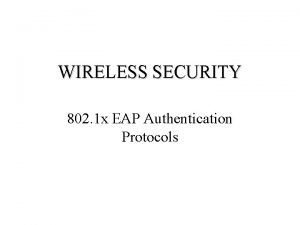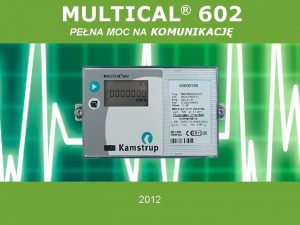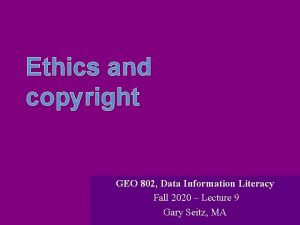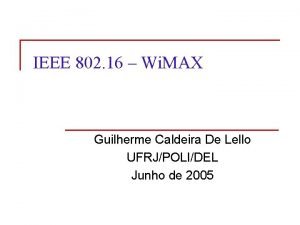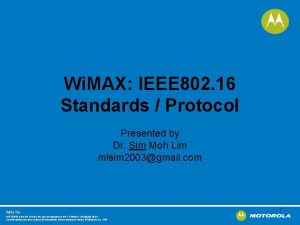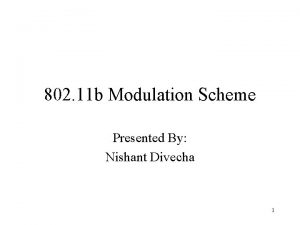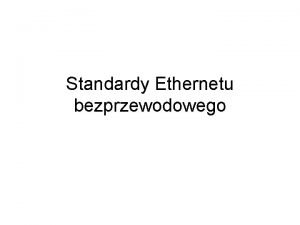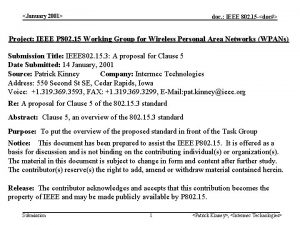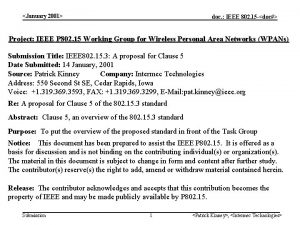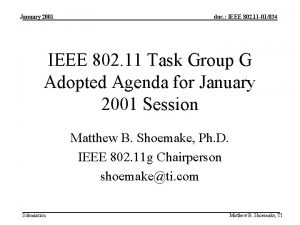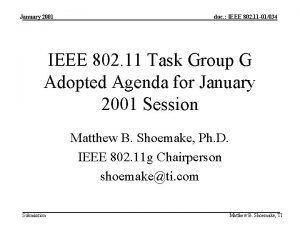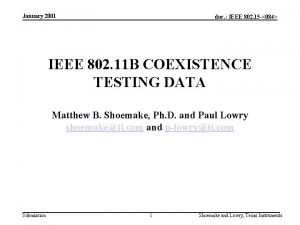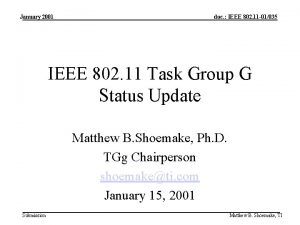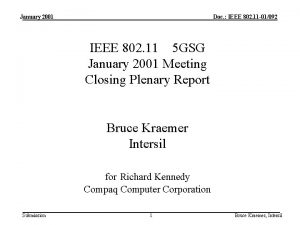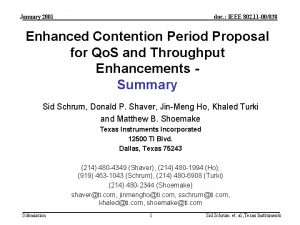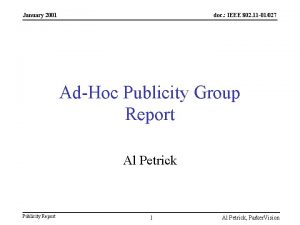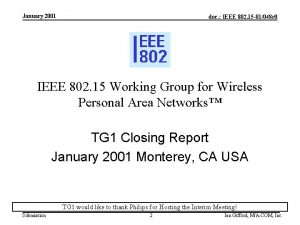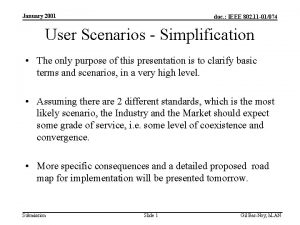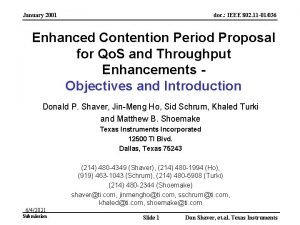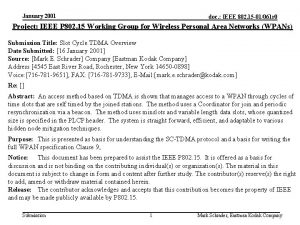January 2001 doc IEEE 802 11 01004 EnhancedDCF


















- Slides: 18

January 2001 doc. : IEEE 802. 11 -01/004 Enhanced-DCF Wireless MAC Protocol: Some Simulation Results Mathilde Benveniste AT&T Labs, Research Submission 1 Mathilde Benveniste, AT&T Labs - Research

January 2001 doc. : IEEE 802. 11 -01/004 Simulation Study Overview • • • TCMA and V-DCF are compared for two network configurations and various traffic loads Three priority classes are considered: High, Medium, and Low – Packets from legacy stations are treated the same as medium priority packets The following statistics are plotted for stream aggregates referred to as “calls”: – – – – Submission Total throughput for all calls (bits per sec) Goodput by call (bits per sec) Goodput/Application load by call Data sent by call (bits per sec) Dropped traffic by call (bits per sec) Media access delay (queueing plus contention time) by call (sec) Retransmissions by call (packets per sec) 2 Mathilde Benveniste, AT&T Labs - Research

January 2001 doc. : IEEE 802. 11 -01/004 Compared Features simulated for TCMA • • • Differentiation by UAT (urgency arbitration time) … by backoff parameters (offset and contention window) used on first transmission attempt … by persistence coefficient used on retrial Absent from simulation • ‘Slow’ adaptation to traffic (initial and retrial backoff parameters) • ‘Fast’ adaptation to traffic (during backoff) • Differentiation by contention time limit • Urgency class upgrade • Differentiation by limit on queueing time Features simulated for VDCF • • Differentiation by backoff offset* used on first transmission attempt … by backoff contention window Absent from simulation • ‘Slow’ adaptation to traffic (initial and retrial backoff parameters) Refs: IEEE 802. 11 -00/375; -00/456; 00/457; -01/002; -01/003 Refs: IEEE 802. 11 -00/398; -00/399; 00/412 r 1; -00/429; -01/011 *Offset can be used only for priorities below legacyequivalent Submission 3 Mathilde Benveniste, AT&T Labs - Research

January 2001 doc. : IEEE 802. 11 -01/004 Class Description *Factor multiplying contention window following collision Submission 4 Mathilde Benveniste, AT&T Labs - Research

January 2001 doc. : IEEE 802. 11 -01/004 OPNET Simulations • Network Configuration • WLAN Parameters • Traffic Statistics – Pairs of stations generate bi-directional traffic streams – One direction generates twice the volume of the other Note: Under certain scheduling assumptions, a node with streams destined to different stations can be modeled approximately as a cluster of stations – DS, 11 Mbps channel rate – Buffer size -- 2, 024, 000 bits – RTS/CTS suppressed – Maximum retry limit -- 7 [See Notes below for OPNET Model settings] – – Submission Frames of fixed size -- 1504 bytes Inter-arrival times exponentially distributed Packet arrival rate determined from scenario traffic load Adjustment for PHY overhead of 192 microsecs must be made 5 Mathilde Benveniste, AT&T Labs - Research

January 2001 doc. : IEEE 802. 11 -01/004 Network Configuration A Traffic 8 stations generate 4 bi-directional streams; stream load split 1 -to-2 between two directions WLAN Parameters DS, 11 Mbps channel buffer size=2. 024 Mbits; no fragmentation RTS/CTS suppressed; max retry limit=7 Submission 6 Mathilde Benveniste, AT&T Labs - Research

January 2001 doc. : IEEE 802. 11 -01/004 Legacy Only 5. 0 Mbps Traffic Loading 2. 5 Mbps 5. 0 Mbps 2. 5 Mbps 0 Submission 30 Time (sec) 7 90 150 Mathilde Benveniste, AT&T Labs - Research

January 2001 doc. : IEEE 802. 11 -01/004 Legacy Only 5. 0 Mbps Traffic Loading 2. 5 Mbps 5. 0 Mbps 2. 5 Mbps 0 Submission 30 Time (sec) 8 90 150 Mathilde Benveniste, AT&T Labs - Research

January 2001 doc. : IEEE 802. 11 -01/004 Priority Qo. S-Enhanced MAC 30 Time (sec) 90 V-DCF TCMA 0 5. 0 Mbps 2. 5 Mbps 150 Submission 9 Mathilde Benveniste, AT&T Labs - Research

January 2001 doc. : IEEE 802. 11 -01/004 Priority Qo. S-Enhanced MAC 30 Time (sec) 90 V-DCF TCMA 0 5. 0 Mbps 2. 5 Mbps 150 Submission 10 Mathilde Benveniste, AT&T Labs - Research

January 2001 doc. : IEEE 802. 11 -01/004 Network Configuration B Traffic 60 stations generate 30 bi-directional streams; stream load split 1 -to-2 between two directions WLAN Parameters DS, 11 Mbps channel buffer size=2. 024 Mbits; no fragmentation RTS/CTS suppressed; max retry limit=7 Submission 11 Mathilde Benveniste, AT&T Labs - Research

January 2001 doc. : IEEE 802. 11 -01/004 Priority Qo. S-Enhanced MAC 30 Time (sec) 90 V-DCF TCMA 0 3. 2 Mbps 1. 6 Mbps 150 Submission 12 Mathilde Benveniste, AT&T Labs - Research

January 2001 doc. : IEEE 802. 11 -01/004 Priority Qo. S-Enhanced MAC 30 Time (sec) 90 V-DCF TCMA 0 3. 2 Mbps 1. 6 Mbps 150 Submission 13 Mathilde Benveniste, AT&T Labs - Research

January 2001 doc. : IEEE 802. 11 -01/004 Priority Qo. S-Enhanced MAC 0 30 Time (sec) 1. 4 100% 1. 2 90% 80% 1 TCMA 90 Percent Retransmissions Goodput / Application Load 70% Call 1 Call 2 Call 3 Call 4 0. 8 0. 6 0. 4 Call 1 Call 2 Call 3 Call 4 60% 50% 40% 30% 20% 10% 0. 2 0 0% 0 20 40 60 80 100 0 20 Time (s) 40 60 80 Time Percent Retransmissions Goodput / Application Load V-DCF 3. 2 Mbps 1. 6 Mbps 150 1. 4 100% 1. 2 90% 80% 1 70% Call 1 Call 2 Call 3 Call 4 0. 8 0. 6 0. 4 Call 1 Call 2 Call 3 Call 4 60% 50% 40% 30% 20% 10% 0. 2 0% 0 0 20 40 60 80 0 100 Submission 20 40 60 80 Time (s) 14 Mathilde Benveniste, AT&T Labs - Research

January 2001 doc. : IEEE 802. 11 -01/004 Priority Qo. S-Enhanced MAC 30 Time (sec) 90 V-DCF TCMA 0 3. 0 Mbps 1. 5 Mbps 150 Submission 15 Mathilde Benveniste, AT&T Labs - Research

January 2001 doc. : IEEE 802. 11 -01/004 Priority Qo. S-Enhanced MAC 30 Time (sec) 90 V-DCF TCMA 0 3. 0 Mbps 1. 5 Mbps 3. 0 Mbps 150 Submission 16 Mathilde Benveniste, AT&T Labs - Research

January 2001 doc. : IEEE 802. 11 -01/004 Priority Qo. S-Enhanced MAC 30 Time (sec) 90 V-DCF TCMA 0 3. 0 Mbps 1. 5 Mbps 3. 0 Mbps 150 Submission 17 Mathilde Benveniste, AT&T Labs - Research

January 2001 doc. : IEEE 802. 11 -01/004 Comparison of TCMA and VDCF Similarities • Both protocols differentiate between different priorities • Both protocols transmit comparable amounts of low priority traffic Differences • TCMA transmits more of the high priority traffic • TCMA causes lower delay to the high priority traffic • TCMA results in fewer collisions Submission 18 Mathilde Benveniste, AT&T Labs - Research











